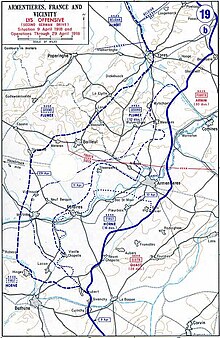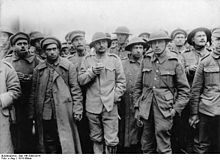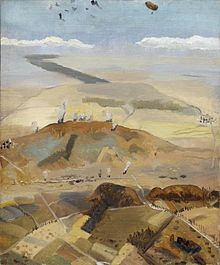Fourth Battle of Flanders
| date | April 9-29, 1918 |
|---|---|
| place | around Ypres , on both sides of the Leie , Belgium and northern France |
| output | Stalemate - termination of the offensive |
| Parties to the conflict | |
|---|---|
| Commander | |
|
|
|
| Troop strength | |
|
|
|
| losses | |
|
109,300 men |
British: 76,300 men |
The fourth Battle of Ypres on the Western Front in World War I , which began on April 7, 1918, is known as the Fourth Battle of Flanders . It lasted until April 29th.
In the German-speaking area, the dispute is counted among the four battles of Flanders and is also referred to as the Battle of Armentieres . In France they are known as la quatrième bataille d'Ypres or la bataille d 'Estaires , but mostly as la bataille de la Lys (named after the river Lys ( Leie )). In the English-speaking world one speaks of the Battle of the Lys (1918) .
prehistory
For the spring of 1918, the German leadership under General Erich Ludendorff planned another offensive on the Western Front to take Ypres. For the German 4th Army , however, the necessary crossing of the up to 12 meters wide and flooded Yser sections in the area north of Ypres was a major problem.
Of the 58 British divisions deployed on the Western Front , 46 had already taken part in the defense of the German offensive on the Somme and in the southern Artois . The British divisions north of the La Bassée Canal were also worn out. Between Bethune and Poperinge only about four divisions stood ready as reserves.
On March 18, 1918, at 3:45 a.m. , the German artillery began bombarding the Allied positions with gas grenades . This was primarily used as a deception to divert attention from the spring offensive between La Fere - St. Quentin - Arras , which began on March 21 .
After Operation Michael got stuck at the beginning of April, the enterprise originally called Georg was carried out on a reduced scale. The code name was Georgette .
course
Battle of Armentieres
On April 9, the 6th Army under General Ferdinand von Quast began the "Georgette attack" from the area between Armentières and Festubert . The infantry attack began after a strong artillery preparation and after gas fire . In the offensive, which was carried out westwards from the area west of Lille , four corps commands with 15 divisions were assigned:
- In the right attack field was the II. Bavarian Corps with the 32nd and 38th divisions and the 10th replacement division
- The focus was on the XIX. Army Corps with the 35th and 42nd Divisions in the first and the 11th and 81st Reserve Divisions in the second meeting. To the left of it the General Command 55 under General von Bernhardi with the 1st and 8th Bavarian Reserve Divisions was assigned. Behind in the second meeting the 8th and 16th divisions .
- The 4th Army Corps was deployed in the southern section , while the 4th Replacement Division was covering Festubert on the left. The 18th and 43rd Reserve Divisions carried out the attack to the north of it, behind them the 44th Reserve Division followed as a reserve . The southern wing of the 6th Army, the XXXX. Reserve Corps remained defensive in the La Bassée area during the battle .
The attack by the 6th Army was directed against the positions of the British 1st Army under General Henry Horne . The front between the La Bassée Canal and Armentières was made up of six divisions of the XI. Corps held under General Richard Haking , two Portuguese defended the section east of Laventie . The XV followed to the north between Armentières and Hollebeke. Corps (General Du Cane ) of the 2nd Army, three divisions of the British IX. Corps ( Hamilton-Gordon ) defended the east-projecting Ypres-Bogen and maintained contact with the Belgian army northwest of Langemark .
The right wing division of Gruppe Stetten (Gen Kdo. II. Bavarian Corps) was able to take the forest of Grenier in a flank to the right, penetrate into Fleurbaix and gain access to the Lys at Bac St. Maur . Other units were then able to use this area as a base for crossing the river, while parts of the Stetten group at Pont Mortier were in a tough battle with the enemy. The lines of the Portuguese 2nd Division under General Gomes da Costa between La Bassee and Le Maisnil were taken over by the German XIX. Army corps breached. Before British units could come to their aid, the Portuguese had lost nearly 7,500 men (total injury, death or captivity). (During the First World War, Portugal temporarily mobilized 56,500 soldiers for the front in France, see Portuguese Expeditionary Corps )
The Kraewel group (Gen. Kdo. IV. AK) jumped the Lys northeast of Sailly, but stuck east of the Lys-Lawe line to the south of Estaires, their left wing hung over the northern edge of Festubert on Givenchy, which cannot be taken could. The Germans took Neuve-Chapelle , extended their breakthrough to the north and south and forced the British to retreat.
The General Command 55 succeeded together with the Carlowitz group (Gen. Kdo. XIX. AK) in taking Estaires . The group Stetten could while another salient around the eastern edge of Armentières Houplines to beat, leading to the capture of the city on the afternoon of 12 April. Armentières fell into the hands of the 38th Division of the II Bavarian Corps. The successful outcome of the Battle of Armentières more than compensated for the loss of terrain in Flanders in 1917 in a few days and created a potential basis for further action. In order to be able to carry on the attack towards Robecq , the General Command IX. Reserve Corps south of the Lys between Merville and Riez du Vinage as the right neighbor of the IV Army Corps with the 239th and 240th Divisions in the front of the AOK 6.
4th Army attacked at Messines
On April 10, further north, the offensive of the German 4th Army under Friedrich Sixt von Armin north of the Lys between Armentières and Hollebeke against the British 2nd Army under Herbert Plumer began . The 4th Army had to attack with its left wing in the direction of Nieppe and Steenwerck. Two more general commands with 6 divisions were scheduled, which extended the battle front to the north:
- XVIII. Reserve Corps with the 7th Division , as well as the 17th and 49th Reserve Divisions
- X. Reserve Corps with the 31st and 214th Divisions , as well as the 36th Reserve Division .
This attack extended to the north hit the section of the British IX. Corps under General Hamilton-Gordon and made rapid progress, the Germans succeeded in taking Messines (Mesen) on the first day . On April 11th, Field Marshal Haig issued the following order of the day to his troops:
“There is no other course open to us but to fight it out! Every position must be held to the last man: there must be no retirement. With our backs to the wall and believing in the justice of our cause, each one of us must fight on to the end. "
“There is no other way open to us than to fight it out! Every position must be held down to the last man: there must be no retreat. With our backs against the wall and believing in the legitimacy of our cause, each of us must fight on to the end. "
At the seam between the 4th and 6th Army, the III. Bavarian Corps and the Guard Reserve Corps with 7 other divisions introduced into battle. On April 12th the newly introduced German Alpine Corps under Major General von Tutschek replaced the 10th replacement division at Steenwerk and attacked Bailleul on the morning of April 13th . The German attackers continued to advance in the direction of the important Hazebrouck supply center . By April 15, they had advanced 3 miles from Hazebrouck and captured Bailleul.
In this situation, Haig requested urgent reinforcements on April 14th from the Commander-in-Chief of the Allied Forces, General Foch . Even the remnants of the Portuguese units were used to reinforce the British forces between Lillers and Steenbecque. Because of the ongoing German attacks in the central section, Foch initially refused to send the required French reinforcements, only two divisions were immediately assigned to the north. At the end of April, however, there were already 7 French divisions in Flanders with the Détachement d'armée du Nord under General de Mitry .
In the attack initiated on April 9th, 21 German divisions were initially deployed. In the second phase of the attack, another 15 divisions from other sections of the front ( 233rd , 235th and 240th Divisions , the 4th Bavarian Division and 13th and 19th Res. Divisions ) were relocated to Flanders as reinforcements, including via Lille 8th Divisions ( 1st Guard Reserve Division , 3rd Guard Division , 4th , 12th , 25th, 39th , 119th and 239th Divisions ) transported from the attack front of the stuck Michael operation.
Attacks on the Kemmelberg
From April 17th to 19th, the British successfully repelled a first German attack on the Kemmelberg . Also Bethune they could hold. On April 18, the resistance at the front of the 6th Army visibly stiffened. The Kraewel group (Gen. Kdo. IV. AK) took possession of the villages of Festubert and Givenchy for a short time , but then had to retreat before the English counter-attacks. The Sieger group ( XVIII. Res.K. ) had to fend off violent counter-attacks near Wytschaete . The Army High Command 6 had to go into defense.
From April 19 to 24 there was a break in combat, while French troops took over the front at Kemmelberg. The French 36th Corps under General Nollet arrived one after the other with three other divisions to reinforce the front there.
In order to give the georgette operation a bearable conclusion, the main focus should now be shifted to the northern attacking 4th Army. As at the beginning of the war, the aim was to master the heights at Messines. The attack plan for the extraction of the high altitude area Kemmel - Dranoutre was drawn up on April 19th. The X. and XVIII. Reserve corps had to carry out the attack. The group of winners should be set up with three divisions in the first and two divisions in the second meeting on the village line Voormezeele, Dickebusch and Kemmel. The Eberhardt group was to advance with a similar attack formation against the Kemmelberg and the heights on both sides of the Vleugelhoek.
The second battle for the Kemmelberg began on the morning of April 25, 1918. The Germans had been firing gas grenades at the Allied positions all night long. The British XXII. Corps under General Godley and the French army under General Mitry defended the important height position. The French reinforced their defenses with strong air strikes. At 6 o'clock the German Alpine Corps managed to storm the Kemmelberg, the French had to retreat to the Rodenberg and Scherpenberg . The attempt of the German armed forces to conquer the Scherpenberg also succeeded on April 29th.
consequences
On April 29, General Ludendorff gave the order to stop the offensive on the Western Front. The losses on the German side amounted to 109,300 men in 28 divisions involved. The 25 British divisions involved in the battle lost 76,300 men and the 8 French 35,000 men, including prisoners. Only a month later, on May 27, 1918, began another German offensive on the Aisne , which led the Germans to the Marne and 92 km from Paris. This advance was ended on June 4, 1918.
The Kemmelberg was retaken by British and Belgian troops during the Hundred Days Offensive at the end of August.
See also
- First Battle of Flanders (from October 20 to November 18, 1914)
- Second Battle of Flanders (from April 22nd to May 25th 1915)
- Third Battle of Flanders (from July 31st to November 6th, 1917)
- Gas war during the First World War
- Trench warfare in World War I
literature
- Reichsarchiv: The World War 1914-1918 , Volume XIV. ES Mittler, Berlin 1944, p. 272 f.






